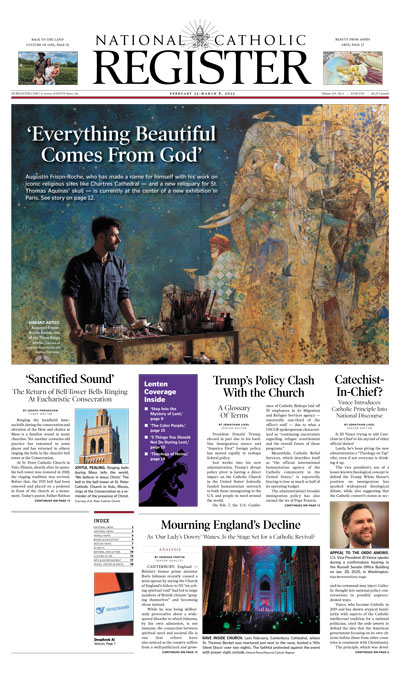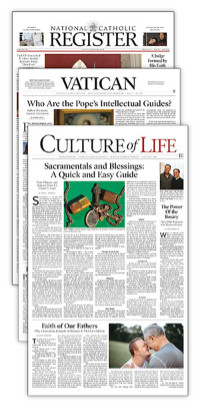Pope Francis’ ‘Lifewatch’ Encapsulates the Real Work of the Catholic Church
COMMENTARY: However, vigils for popes, like the current one for Pope Francis, have been the exception, not the rule.

Twenty years ago, as Pope St. John Paul II entered the last weeks of his life, I wrote that a papal “deathwatch” — as some inelegantly styled it — was really a “lifewatch.” John Paul was teaching the world how to suffer and to die, which is an important part of how to live.
“John Paul II is aging, deteriorating and moving closer to his death,” I wrote.
“In the meantime, a period of reflection, contemplation and prayer will increasingly occupy himself and the Church. But reflection, contemplation and prayer are not something to pass the time until the Church can get back to work — they are the work of the Church. Aging and deterioration are part of life too. So let the lifewatch continue. There is enough to see now, without looking anxiously ahead.”
The lifewatch for Pope Francis has begun, even as the most immediate crisis seems to have passed. The Church is getting to work. On Monday night, pilgrims prayed the Rosary in St. Peter’s Square for the Holy Father, as it was 20 years ago, though then John Paul was above the square in the Apostolic Palace. He had by then come home to die. Pope Francis is at the Gemelli hospital, as he is still responding to treatment. The Church’s work remains the same, namely to get disciples — including the Supreme Pontiff — ready for death.
“We of the Catholic family, and so many of our friends and neighbors find ourselves this morning at the bedside of a dying father,” Cardinal Timothy Dolan of New York said on Sunday at St. Patrick’s Cathedral. “Our Holy Father, Pope Francis is in very, very fragile health and probably close to death.”
A lifewatch is a blessing. Families who have had the grace to accompany their loved ones in the days before death know that. But for the Church as a whole regarding the Holy Father, a lifewatch is the exception, not the rule.
Now, we know that popes are sick when they are hospitalized. Until John Paul II, it was not customary for popes to go to the hospital; they were treated in the Apostolic Palace. A makeshift surgical suite was set up there in 1967 for Pope St. Paul VI. Hospitalization means that the world knows that the pope is in danger; the Church knows that it must pray and keep vigil.
Recent experience has been that popes have died rather quickly, without an extended final illness.
St. Pius X (1914) and Pope Pius XI (1939) were only seriously sick for a few days before they died at the Vatican. Venerable Pius XII had serious health difficulties in the last four years of life, but in 1958 he was working a full day as late as Oct. 5. He died in the early morning of Oct. 9 at Castel Gandolfo, removed from Rome.
St. Paul VI also died at Castel Gandolfo, at the height of summer vacation, so he was not expected to have public engagements. When his death was announced, it was not widely known that he was seriously ill. He died on Aug. 6, 1978, the feast of the Transfiguration, at Castel Gandolfo.
Paul VI did seem to know that the end was near. His last homily was delivered on the solemn feast of Peter and Paul, June 29. It was just days after the 15th anniversary of his election, and he preached a valedictory, applying to himself the words of his papal patron saint.
“This the Church’s faith, the apostolic faith,” Paul VI said. “‘I have kept the faith!’ I can say today, with the humble but firm consciousness of never having betrayed ‘the holy truth.’”
Nevertheless, even at age 80 in the summer of 1978, it was not expected that he was in his final months.
Paul VI’s successor, Blessed John Paul I, had the most unexpected death of all, dying suddenly during the night only a month after his election.
The only opportunity for a lifewatch before John Paul was that of St. John XXIII. He had been diagnosed with stomach cancer in the fall of 1962.
By May 1963, it was clear that the end was coming. He was in Rome and in the Apostolic Palace; it was known that he was dying. People gathered in St. Peter’s Square to pray for him; he died on June 3, 1963, soon after a Mass, which had been offered for him in St. Peter’s Square, finished.
In his book on the seven last words of Christ, Death on a Friday Afternoon, Father Richard John Neuhaus recalled the very public witness to the faith of a dying Pope John XXIII:
“I recall being deeply impressed as a young man by the death of Pope John XXIII. It was slow in coming, and over the days there were regular news bulletins reporting that he was offering up one day’s suffering for those with cancer, another day’s suffering for homeless refugees, another for mothers with difficult pregnancies and so forth. He seemed to be going about his dying with such purpose, with almost workmanlike efficiency, wasting none of it.”
When Benedict XVI died Dec. 31, 2022, he had been out of the public eye in retirement for nearly 10 years. Pope Francis announced that he was in his last days on the Wednesday after Christmas; he died on Saturday.
The prayers for Pope Francis in St. Peter’s bring back vivid memories of John Paul’s final agony. Too weak to lead the Holy Week ceremonies, he followed the Stations of the Cross at the Colosseum on Good Friday from his private chapel, where a television had been set up. He watched while cradling a crucifix in his own arms. The image of that moment, shot from the back, an old man wrapped around the cross of Christ, was the summation of a life of discipleship well lived.
On Easter Sunday, John Paul came to the window of the Apostolic Palace to deliver an abbreviated urbi et orbi address. The stripping away was complete; the Holy Father tried mightily, but he could not speak.
After repeated attempts, he blessed the people and withdrew. He would attempt the same the following Wednesday, but he was no longer capable. On Thursday and Friday, the people gathered to pray in the square.
His closest curial collaborators came to bid him farewell, to bless him and be blessed one final time. Cardinal Joseph Ratzinger came on Friday. The Mass of Divine Mercy was offered in his room on Saturday evening. He died shortly afterward, at 9:37 p.m. The announcement was made in St. Peter’s Square, and the great bells began to toll.
The lifewatch of Pope Francis will follow its own course. The Vatican press reports indicate that there has been a slight improvement and that he is resting well. Yet there have been no images of the Holy Father released during his hospital stay, and very few senior officials have visited him.
The Curia continues to operate — the papal message for Lent was released, decrees regarding new saints have been approved, and episcopal appointments continue to be announced.
And, in St. Peter’s Square, the real work of the Church is being done.
- Keywords:
- pope francis health
- john paul ii
- death and dying

















